



Article by: Hari Yellina
In roughly three weeks, Australian motorists will likely witness the worst of the effects of the Ukraine/Russia crisis on fuel prices, when the increase in wholesale prices seeps through to drive up already high retail prices. Prices have already surpassed $2 a litre in certain areas, and with Brent crude oil prices topping $100 a barrel for the first time since 2014 without Russia, the world’s second largest oil supplier, on the market, it is expected that fuel costs will remain high at least until the war is resolved. According to industry analysts, gasoline prices could reach $2.10 in major cities, implying considerably higher prices in rural areas.
While some were pessimistic about a sustained time of record high retail fuel prices, Mark McKenzie, chief executive of the Australasian Convenience and Petroleum Marketers Association, said there were various variables to suggest this might not be the case. He cited the drop in futures prices after the initial jump after the declaration of war last week. “There were significant gains on futures as war was declared, but then the market took time to ponder, and perhaps it was considered that a lot of the risk premium had already been built into the market,” Mr McKenzie said. “Scaling up or scaling down pricing in the oil supply chain is not like flicking a light switch; it takes time, but with prices where they are now, there is obviously an incentive for those with capacity to produce more oil.”
Many suppliers have taken a cautious approach to expanding capacity in the aftermath of COVID-19, which saw a drop in demand and, as a result, the lowest gasoline costs in years, so there is definitely potential to increase output. The conflict between Russia and Ukraine, according to Mr McKenzie, has changed the dynamics of the oil market. Prices had been creeping up since COVID-19’s high until the end of October, and then things started to soften slightly as new production came online, bringing some respite, which was expected.
Mr McKenzie, on the other hand, said the Australian consumer had something going against them this time around that they didn’t have the previous time global petrol prices reached to these levels in 2013-14. “Currency is suffocating us.” “The dollar was at US92c the last time we saw world prices like these, and it’s now around US72c, so we’re 26pc worse off on that front.” Mr McKenzie opined that he does not believe that current fuel prices are high enough to deter Australian motorists from driving.